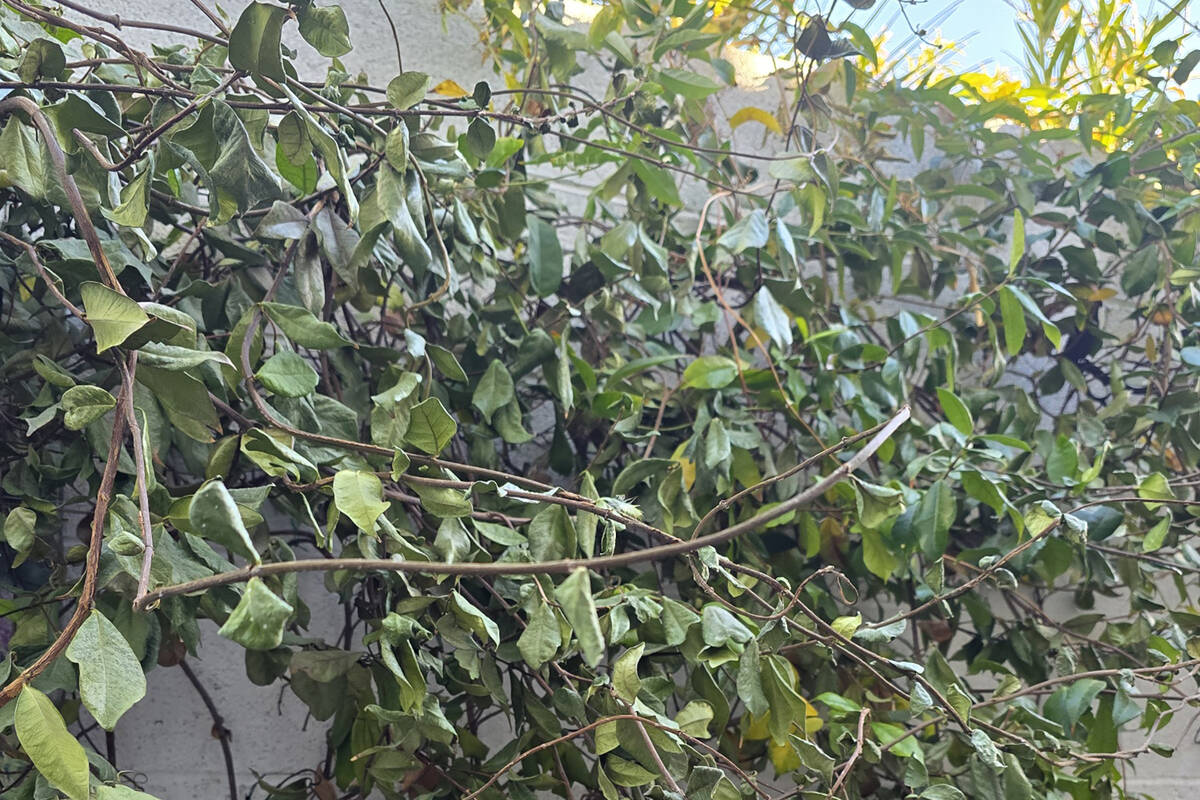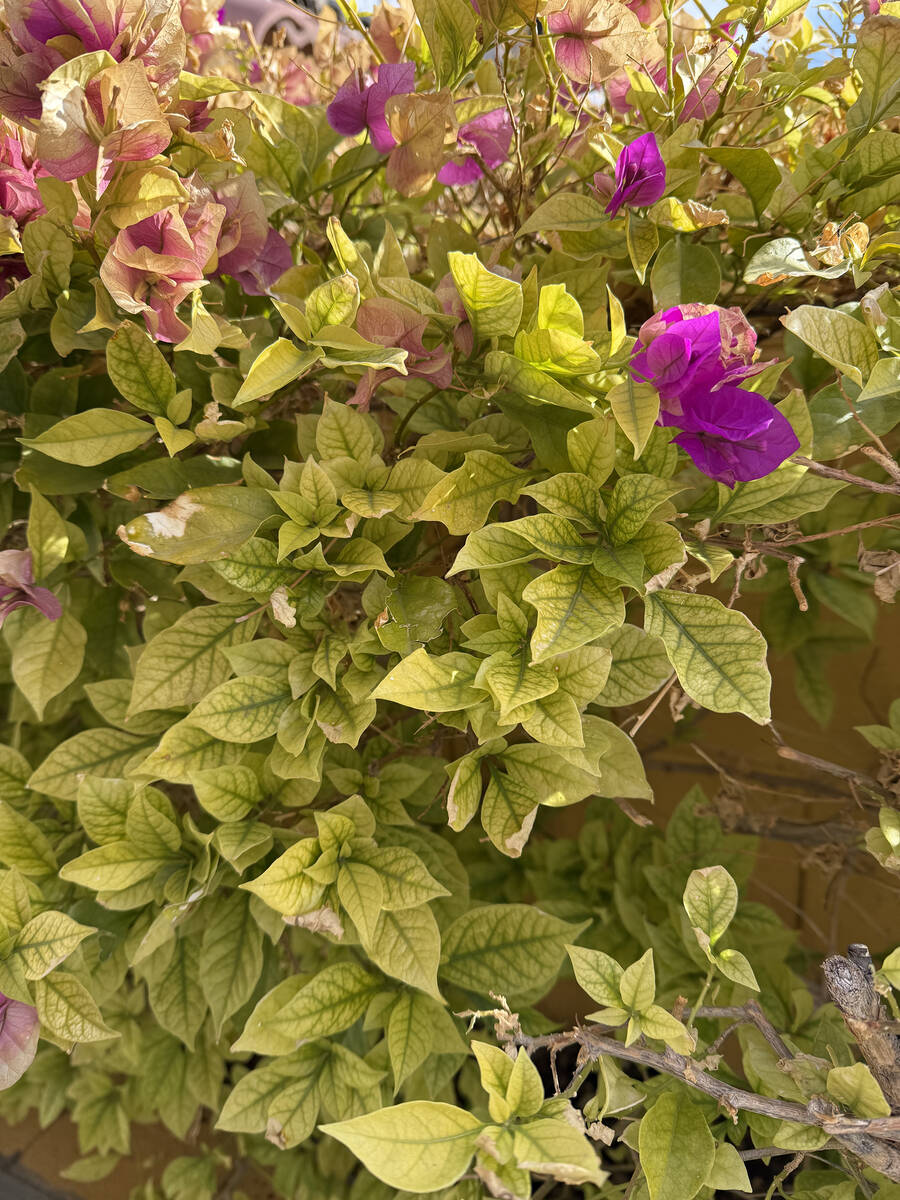What’s causing my star jasmine’s recent struggles
Q: Since about two weeks ago, one of my walls of star jasmine has been struggling with dry and dull green leaves. Some parts are still green and lush, but I’m not sure how long that will last. They were last fertilized on Oct. 16. I asked my landscaper, and he has no clue except to say the plant is still alive as the branch is still green inside (he gently scraped it to check). I have three star jasmine on the same wall, and two of them are normal. I switched to winter watering, which is once a week at 8 a.m., 3 p.m. and 10 p.m., 20 minutes each cycle, since Nov. 1. I gave the struggling star jasmine a little boost every Sunday with a soil additive at 4 tablespoons per gallon. What else can I do to save the plant? It’s 4 years old.
A: Most of your problems seem to center on not getting enough gallons of water to the plant roots. When not enough water gets to the roots, a water shortage will occur around June, July or August when it starts to get hot.
I understand that you are limited in the gallons you apply because of the time. Either add more drip emitters and keep the duration the same or increase the minutes that water all the plants on that valve. I would add more emitters rather than increase the minutes. The increase in the number of emitters should result in less water applied in the long run.
If not enough water applied is the problem, during the fall months is the time to get the plants to recover. You should know if that is the problem in about two months or so during cold weather.
Check if the rock covering (lack of soil organics) is causing a problem. Star jasmine is notorious for lack of tolerance to two things: low soil organics and a lack of available iron in the soil. If there is rock at the base of star jasmine, rake it back and apply compost on top of the soil. Apply about 4 to 5 cubic feet of compost to the wet soil for every 10 feet. Not much. Do that once a year. Or replace the rock with wood chips, or do both if it’s bad.
Next apply iron to the compost (or bare soil) where the drip emitters wet the soil. Follow label directions for how much to apply. Apply iron in late January to early March.
Q: I seem to have an extreme issue with chlorosis (leaf yellowing). I had a blood orange and kumquat in one area. After a couple of years, they showed a problem with leaf chlorosis. Then in another area I had three bougainvillea. After six years, one had a problem, and the next year the other two showed the same leaf yellowing. I then adjusted my plants with less water and still no change. I have tried IroniteR, a form of chelated iron, calcium and zinc, Miracle GroR, seaweed fertilizer, water and sulfur. I realize my soil is alkaline (somewhere above 7 pH), and hence the iron and sulfur. Nothing seems to be helping. Could this be an airborne disease problem? I have a large bougainvillea within feet of the blood orange area that is growing beautifully.
A: Yes, you have an extreme issue with chlorosis. The cause of the leaf yellowing is usually iron.
But after your description of the problem, I question that. This chlorosis could be caused by the lack of an available nutrient (most often iron). Some plants are more subject to the lack of this plant nutrient than others.
In rare cases, leaf yellowing may be due to a lack of available manganese or zinc. It is usually not “biotic” disease (caused by a living organism such as fungi, bacteria, virus or nematodes) but is considered an “abiotic” disease (not caused by a living organism).
This lack of a common plant nutrient (iron) should be tried first or you won’t know what the cause is. Correcting an iron availability problem relies on knowing the effects that alkalinity has on it. You are right when saying it is worse when the soil pH is alkaline). In fact, it usually is worse when the soil pH is above 7.6.
You might correct this soil nutrient problem by lowering the soil pH to an acceptable range. You do that with a rich compost, not sulfur. Visit Viragrow Inc. in North Las Vegas and buy its rich compost (called 166 compost). The second thing you will buy is the correct chelated iron for our soil, EDDHA. That is the only company that carries that iron chelate (EDDHA combined with 6 percent iron) for our desert soil.
After irrigation, try adding this rich compost to the soil around your yellow citrus tree. That will help the soil lower its alkalinity, in place of finely ground sulfur. To do that, rake back any rock about 3 to 4 feet from the trunk in all directions until you reach bare but moist soil. Apply 166 compost as a thin layer (one-quarter inch). Do that in the fall or early spring. You should do that about once a year to citrus trees anyway if you apply rock mulch to the top of the soil.
Next apply iron. Apply EDDHA chelated iron only in February or early March. Follow the label. That should correct this problem on new growth only. If you want to correct the yellowing on more mature leaves, you must spray the leaves with an iron solution.
Spraying the leaves more than once gets the tree leaves a darker green each time. Leaf or foliar sprays bypass the roots. It is not the preferred way to get nutrients inside the leaves, but it usually works. You can do that anytime the leaves are present.
Take the same iron product and mix it in a gallon of distilled water. Follow the label directions.
Bob Morris is a horticulture expert and professor emeritus of UNLV. Visit his blog at xtremehorticulture.blogspot.com. Send questions to Extremehort@aol.com.



















